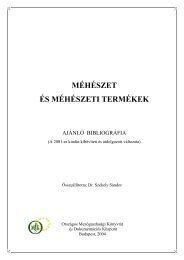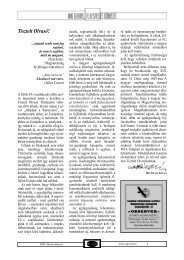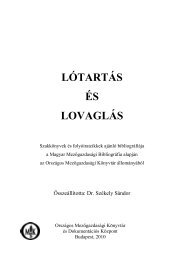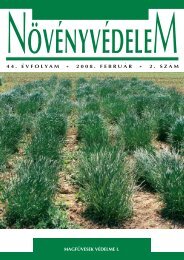hUNGARiAN AGRicUltURAl RESEARch
hUNGARiAN AGRicUltURAl RESEARch
hUNGARiAN AGRicUltURAl RESEARch
Create successful ePaper yourself
Turn your PDF publications into a flip-book with our unique Google optimized e-Paper software.
Zoltán Kováts 1<br />
Breeding Of Outdoor Ornamental Plants Adapting<br />
Well To Climatic Changes<br />
The possible effects and<br />
phenomena of climate change have<br />
been discussed for several decades<br />
by tens of thousands of scientists of<br />
various disciplines with increasing<br />
frequency and intensity and<br />
involving more and mores fields.<br />
Agriculture, including horticulture,<br />
is particularly affected by<br />
these changes.<br />
The opinions relating to the<br />
issue are quite diverse. Many<br />
people agree that the Earth’s<br />
climate is warming, however, it is<br />
also often projected that increase in<br />
the occurrence of extreme weather<br />
events may cause as severe damage<br />
as the rise in temperature.<br />
The solutions suggested to<br />
counteract these trends are highly<br />
variable and documented by<br />
countless publications. In the<br />
present essay we examine the<br />
question from the aspects of plant<br />
breeding, particularly that of the<br />
improving of ornamental plants.<br />
As for the problem of climate<br />
change, it is the breeding of<br />
outdoor ornamental plants that are<br />
important, of course. In Hungary,<br />
herbaceous seed-propagated plants<br />
developed in the country for more<br />
than half a century are of main<br />
interest. The varieties created by<br />
this research work have proved to<br />
be successful in both domestic and<br />
foreign markets.<br />
The improvement of tolerance<br />
to drought and heat is the most<br />
important breeding aim of all.<br />
Hungary has continental climate<br />
with extreme temperature values,<br />
and the amount of precipitation<br />
Alcea rosea<br />
here is less than in the regions of<br />
Europe where most of the research<br />
was conducted in the 19 th and 20 th<br />
century. In the past, the breeding of<br />
outdoor – mainly annual –<br />
ornamental plants was carried out<br />
in Germany, the Netherlands and<br />
Great Britain under more humid,<br />
cooler and more uniform weather<br />
conditions.<br />
These varieties were imported<br />
to and used widely in Hungary, but<br />
the intensive research work started<br />
in the 1950s demonstrated that<br />
Alcea biennis<br />
Alcea rosea<br />
most of them are not really suitable<br />
for use here. The concept that<br />
drought tolerance is required<br />
principally with the intention of<br />
saving water has turned out to be<br />
wrong. It was proved that the<br />
duration of blooming of several<br />
ornamental plant species was<br />
shorter in Hungary than in<br />
countries with oceanic climate<br />
because the vital functions of<br />
plants were accelerated by the<br />
higher temperature and stronger<br />
solar radiation, resulting in faster<br />
Alcea rosea Balaton<br />
1Research Institute for Fruit growing and Ornamentals Park u. 2. Budapest, Hungary, H-1223 P.O. Box 108, Budapest 1775<br />
Tel.: (+361) 362-1571, 362-1596/104 Fax: (+361) 362-1573, E-mail: resinfru@hu.inter.net<br />
4 Hungarian Agricultural Research 2009/3–4
















